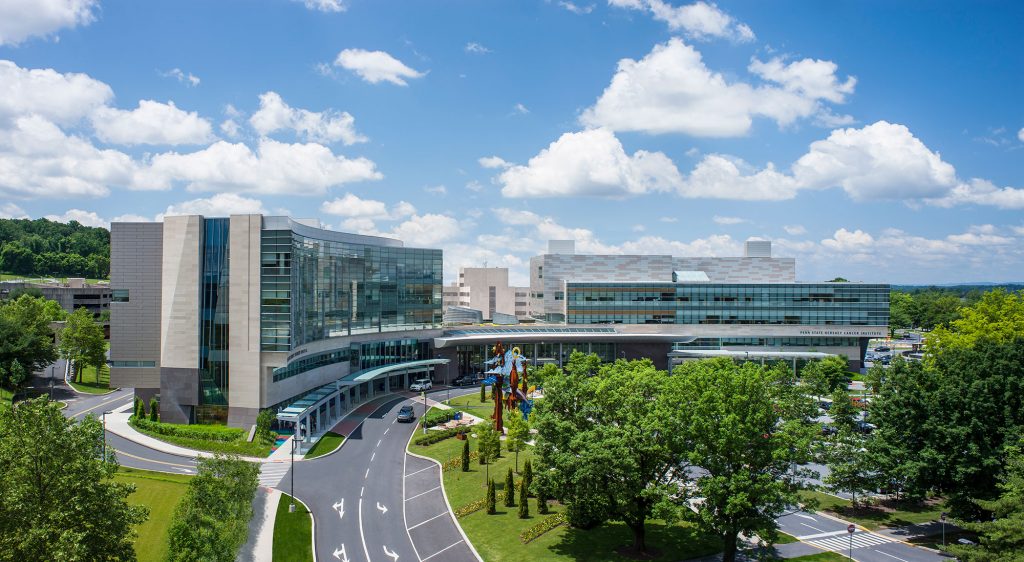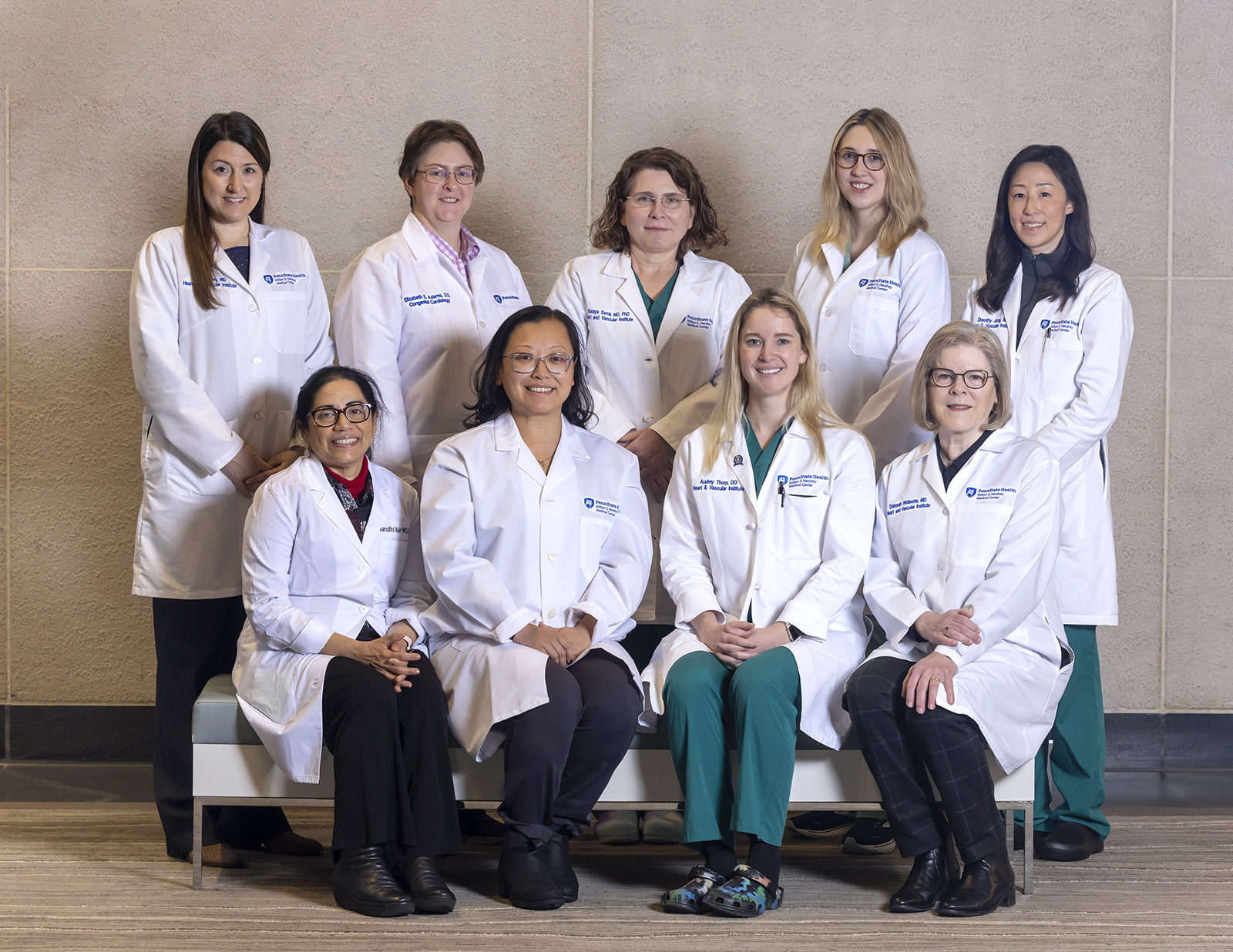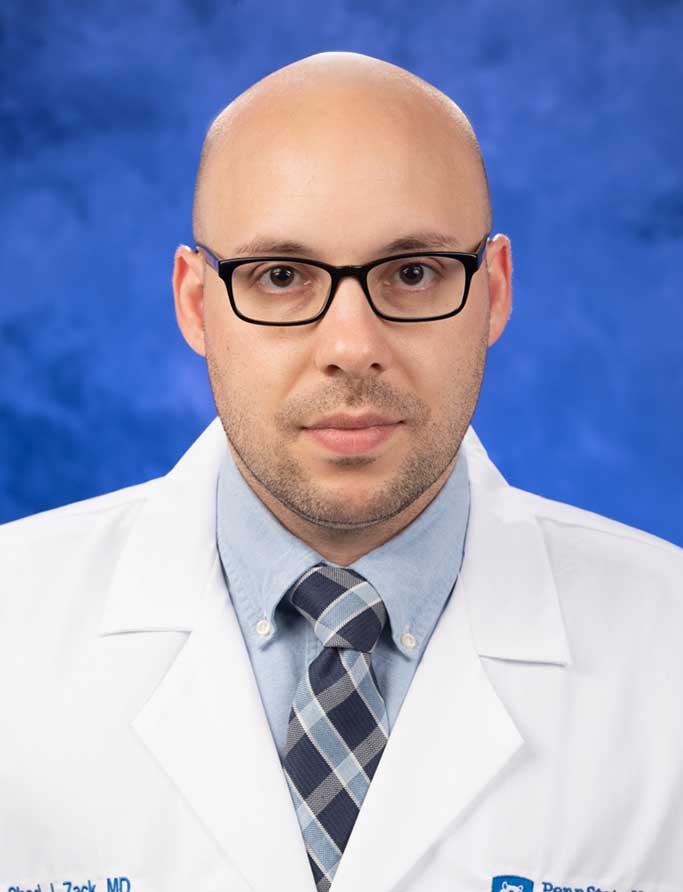Jump to topic
Search
Program Details
The Interventional Cardiology Fellowship provides fellows with state-of-the-art training. To be a candidate for this ACGME-approved training position, the qualified candidate will be completing (or already has completed) a three-year ACGME-accredited cardiovascular disease fellowship, as well as a three-year ACGME-accredited internal medicine residency. It is expected that the candidate be board-certified in internal medicine and be board-eligible for cardiovascular disease medicine by the start of the training program.
The program is designed to meet all of the requirements for board eligibility in Interventional Cardiology and provides level 3 COCATS training.
The interventional cardiology fellow will be provided with an opportunity to acquire knowledge of the indications, contraindications, risks, limitations and complications associated with catheter-based interventions, and will perform a minimum of 250 coronary interventions during training. The program will provide instruction and opportunities to acquire knowledge in the use of IVUS, Excimer laser, cutting-balloon, PTCRA, intracoronary stents, distal protection devices, pressure and Doppler flow wires. In addition, the fellow will participate in ongoing clinical trials studying the effects of pharmacological therapies and new interventional devices.
Penn State Heart and Vascular Institute has five attending interventionalists. The fellow will work in tandem with an attending interventionalist in the cath lab and clinic.
Learn More about the Fellowship
Application Overview
All applications must be submitted through ERAS, and the program participates in the National Residency Matching Program (NRMP). Applications will not be received outside of ERAS, and positions will not be filled outside the match.
Application deadline is July 31, 2024.
Eligibility
Qualified candidates will be:
- U.S. citizens, permanent residents or J-1 visa holders (no additional visa types are sponsored)
- Board-eligible or board-certified in internal medicine
- Pennsylvania medical training license eligible
Required Supporting Documents
The following documents should be uploaded to ERAS for review:
- ERAS application, inclusive of current photograph
- Personal statement
- Curriculum vitae
- USMLE or COMLEX transcript
- ECFMG certificate (if applicable)
- Letters of recommendation – minimum 3-4 letters, including one from current program director
Interview Process
Thank you for your interest in our program. Interviews are expected to take place virtually for 2024; however, this is subject to change, and we encourage you to check back often.
Interview dates for 2024 will be:
- Oct. 3
- Oct. 9
- Oct. 17
- Oct. 23
All interviews are by invitation only and will be scheduled through Thalamus.
Virtual Tour
Penn State Health
Penn State Health is a multi-hospital health system serving patients and communities across 29 counties of Pennsylvania. Its mission is to improve health through patient care, research, education and community outreach.
In December 2017, the system partnered with Highmark Health to facilitate creation of a value-based, community care network in the region. The shared goal of Highmark and Penn State Health is to ensure patients in the community are within:
- 10 minutes of a Penn State Health primary care provider
- 20 minutes of Penn State Health specialty care
- 30 minutes of a Penn State Health acute care facility
Learn more about Penn State Health

Penn State Health Children’s Hospital (left), Penn State Health Milton S. Hershey Medical Center (center) and Penn State Cancer Institute (right)
Penn State Health Milton S. Hershey Medical Center
500 University Dr., Hershey, Pa., 17033 (Derry Township, Dauphin County)
- The health system’s 647-bed flagship teaching and research hospital
- The only medical facility in Pennsylvania accredited as both an adult and a pediatric Level I (highest-level) trauma center
- Dedicated surgical, neuroscience, cardiovascular, trauma and medical intensive care units
- Accredited Life Lion critical-care transport providing more than 1,100 helicopter and approximately 750 ground ambulance transports per year
- More than 1,300 faculty members and more than 650 residents and fellows
- Approximately 29,000 admissions, 73,000 emergency department visits, 1.1 million outpatient visits and 33,000 surgical procedures annually
- Designated as a Magnet hospital since 2007
Learn more about Milton S. Hershey Medical Center
Penn State Health Children’s Hospital
600 University Dr., Hershey, Pa. 17033 (Derry Township, Dauphin County)
- An eight-story, 263,000-square-foot-facility built in 2013 and expanded in 2020
- 160 licensed pediatric beds, 26-bed pediatric intensive care unit and a 56-bed neonatal intensive care unit
- Level IV (highest-level) neonatal intensive care unit
- Level I quaternary (highest-level) pediatric intensive care unit
- Level I (highest-level) pediatric trauma center designation
- Intermediate care unit
- Dedicated pediatric operating rooms
- More than 150,000 pediatric outpatient visits, 20,000 pediatric emergency room visits, and approximately 5,000 pediatric patient discharges annually
Welcome to Hershey
More About Hershey
Interested in learning more about living and working in Hershey, Pa.? See details here:
Wellness, including emotional, spiritual, social and physical health, is a crucial component to training and to becoming a professional, compassionate and resilient physician. Self-care is a skill which must be continually practiced and reinforced. Penn State College of Medicine and Penn State Health are committed to addressing wellness among residents and fellows, with multiple resources readily available.
Institutional resources
- Visit BeWell – a health program designed to support Penn State Health employees
- See Penn State College of Medicine wellness resources here
- Employee Health Care Concierge and Case Management Service
- Partners in Medicine
Moving to a new city with your family does not have to be stressful. Residency programs have assisted many significant others with finding employment. There is also a GME-Wide Partners in Medicine (PIM) group that offers networking opportunities as well as various social and community oriented activities. - The Doctors Kienle Center for Humanistic Medicine
- Active and easily accessed Office of Professional Mental Health
Graduate medical education resources
Institutional Resources
Penn State Health and Penn State College of Medicine celebrate, embrace and support the diversity of all patients, faculty, staff, students and trainees.
Office for Diversity, Equity and Inclusion
In keeping with this, Penn State Health has an active Office for Diversity, Equity and Inclusion with various programs, networks and resource groups, including:
- Talks and lectures on diversity, equity and inclusion through the Inclusion Academy
- Regular events on topics such as eradicating racism and creating a culture of inclusiveness
- Many Business Employee Resource Groups (BERGs), including:
- Disability Business Employee Resource Group
- Interfaith Business Employee Resource Group
- LGBTQ+ Business Employee Resource Group
- Military and Veterans Business Employee Resource Group
- Multicultural Business Employee Resource Group
- NextGen Business Employee Resource Group
- Black Physician Professional Staff Association – Resource Group
- Hispanic Professional Association
- Asian Physician and Professional Staff Association
- International Workforce Inclusion
Learn more about the Penn State Health Office for Diversity, Equity and Inclusion
Learn more about the College of Medicine’s Office for Diversity, Equity and Belonging
Office for Culturally Responsive Health Care Education
The vision at Penn State College of Medicine and Penn State Health is to equip learners with the knowledge, skills and attitudes they will need to provide culturally excellent health care and research for an increasingly diverse U.S. population. The Office for Culturally Responsive Health Care Education was formed to help meet that goal.
Learn more about the Office for Culturally Responsive Health Care Education
Office for a Respectful Learning Environment
In addition, the institution does not tolerate discrimination, biases, microaggression, harassment or learner mistreatment of any kind, and any concerns are immediately addressed by the Office for a Respectful Learning Environment.
Learn more about the Office for a Respectful Learning Environment
Network of Under-represented Residents and Fellows
The Network of Under-represented Residents and Fellows (NURF) is a group of diverse residents and fellows representing all specialties. NURF’s goal is to promote cultural diversity in the residency programs through community involvement, mentorship with diverse faculty, professional networking and support for the recruitment of diverse medical students into the residency programs.
NURF is sponsored by the Penn State College of Medicine Graduate Medical Education Office and the Penn State Health Office for Diversity, Equity and Inclusion.
Leadership

Amanda Cai, MD
Faculty Leader

Dorothy Jung, MD
Fellow Leader
Overview
Women in Cardiology:
- Strives to foster a supportive environment for women in Cardiology and its subspecialties at Penn State Hershey Medical Center
- Offers unique opportunities to address and support career-focused education for women within our field
- Provide resources for leadership, mentoring and families
- Minimum of bi-annual events for participation
- Attending and fellow-level support system

Mailing Address
Penn State Heart and Vascular Institute
Interventional Cardiology Fellowship Program
500 University Drive
P.O. Box 850, MC H047
Hershey, PA 17033
General Contact Information
Phone: 717-531-6746
Curriculum Details
The Interventional Cardiology fellowship training program extends for a period of one year. This one-year program complies with all Accreditation Council for Graduate Medical Education (ACGME) requirements, in addition to following the guidelines and recommendations of the American College of Cardiology’s (ACC) COCATS. All applicants entering Interventional Cardiology must have completed an ACGME-accredited Cardiovascular Disease fellowship or its equivalent.
A subspecialty educational program in Interventional Cardiology must function as an integral component of an accredited subspecialty fellowship in Cardiovascular Disease. Therefore, the guidelines that follow are complementary to those in general cardiology.
Program Objectives
The Interventional Cardiology fellowship training is designed to provide the fellow with COCATS Level III training. Specific curricular milestones for training in Coronary Angiography and Intervention and Peripheral Vascular Angiography and Intervention, as they relate to the Core Competencies promulgated by the ACGME, are adopted as outlined in the COCATS 4 Task Force 10 document. They are included in this curriculum with the appropriate associated Evaluation Methods for fellows. Additionally, specific curricular milestones for Ambulatory and Longitudinal Care, as well as Research, are also included.
Procedural Training
In order to ensure the appropriate training of the Interventional Cardiology fellow the training program will ensure that a minimum of 400 interventional procedures are performed per year and that the Interventional fellow has the opportunity to acquire skill in the performance of a minimum of 250 coronary interventions.
The program provides instruction and opportunities to acquire knowledge in the following:
- Pathophysiology of atherosclerosis and response to vascular injury
- Pathophysiology of restenosis
- Role and limitations of therapy for restenosis
- Advanced invasive cardiac imaging (ICE, OCT, NIRS, IVUS, FFR)
- Detailed coronary, valvular, and structural anatomy
- Radiation physics, biology, and safety related to the use of X-ray imaging equipment
- Critical analysis of published interventional cardiology data in laboratory and clinical research
- Role of randomized clinical trials and registry experiences in clinical decision-making
- Cardiovascular pharmacology
- Valvular and structural heart diseases
- Adult congenital heart disease
- Devices
- Ultrasound for vascular access and intracoronary imaging
- DES and bare metal stents
- Bioresorbable vascular scaffolds
- Rotablator, orbital atherectomy
- Thrombectomy devices
- Distal and proximal protection devices
- iFR and FFR
- Impella and support devices
- Left atrial appendage occlusion
- MitraClip
- TAVR
- PVL repair
The Interventional Cardiology fellow will spend approximately 10 months in the Cardiac Catheterization Laboratory at Penn State Health Milton S. Hershey Medical Center and has two electives that may be spent elsewhere in order to enhance their experience in technology not available at Penn State Health Milton S. Hershey Medical Center. For each elective month the Interventional Cardiology fellow will be evaluated by attending staff with whom they have had significant contact with at each of the teaching institutions.
Ambulatory Clinic
The Interventional Cardiology fellow is required to spend one half-day a week in the outpatient clinic for the follow-up of patients treated with drugs, interventions, devices, or surgery. In this setting, they are also expected to be involved in the pre-procedural workup of interventional cases. This outpatient exposure is expected to focus and build on the experience already gained during general cardiology training.
Clinical Research
During the Interventional Cardiology training year the fellow is expected to be involved in clinical research in order to foster their experience and to understand the role of randomized clinical trials and registry experiences in clinical decision making. Quality and safety improvement projects along with a focused review on practices relating to interventional cardiology will also be considered as research efforts during this one-year fellowship.
The fellow will become familiar with:
- All aspects of pharmacologic interventions as they relate to the interventional patient. These include platelet inhibitors, all anticoagulants and thrombolytic drugs, as well as beta blockers, calcium channel blockers and nitrates as they relate to the catheterization laboratory. As well, the trainee will become familiar with emerging data as they relate to free radical scavengers, leukocyte inhibitors and other aspects of the inflammatory process.
- All aspects of the performance and management of complications of routine coronary and peripheral angioplasty. This includes both elective and complex and multivessel interventions, as well as other mechanical interventions for acute myocardial infarction. This will include the management of restenosis, the management of chronic total occlusions, reperfusion angioplasty and supported/protected angioplasty.
- New device technologies. This includes receiving full exposure and training to rotational atherectomy, clot extraction technology, future innovative devices and all aspects of intravascular imaging.
- Indications for and technique of percutaneous intracardiac defect closure (ASD, PFO) and the technical aspects of TEE or intracardiac echo guidance of these procedures.
- Performance of aortic and mitral balloon valvuloplasty as well as pulmonary valvuloplasty.
- TAVR procedures, including participating actively in pre- and post- procedure care of the TAVR patients.
The principal teaching method by the faculty follows the recommendations and guidelines set forth by the American College of Cardiology, the Society for Cardiovascular Angiography and Interventions, and the American Heart Association and covers the following:
- Anatomy: Cardiac, vascular and coronary artery anatomy, including anatomic variants and congenital abnormalities.
- Physiology: Basic circulatory physiology, coronary vascular physiology, myocardial blood flow regulation, myocardial physiology and metabolism.
- Vascular biology and pathology: Normal vascular structure and function, response to injury, mechanisms of atherosclerosis and mechanisms of restenosis.
- Hemostasis: Intrinsic and extrinsic coagulation cascade and platelet physiology.
- Pathophysiology: Myocardial ischemia and infarction, myocardial reperfusion, circulatory shock, anaphylaxis and cardiac arrhythmias.
- Pharmacology: Anticoagulants, antiplatelet drugs, thrombolytic drugs, X-ray contrast agents, myocardial inotropes, vasopressors, vasodilators, antiarrhythmic drugs and drugs affecting lipid metabolism.
- Radiology imaging and radiation safety: Principles of X-ray imaging, quantitative coronary arteriography, operation of cinefluorographic X-ray equipment, operation of digital video imaging systems, radiation biology and radiation protection.
- Intracoronary imaging and coronary physiology: Principles of intravascular ultrasound imaging and Doppler coronary flow velocity and coronary pressure measurements.
- Interventional device design and performance: Device materials and characteristics.
- Clinical management strategies: Performance and limitations of interventional devices, spectrum of coronary ischemic syndromes, results of interventional cardiology clinical trials, management of acute hemodynamic alterations and mechanical and pharmacological circulatory support.
- Attend the Cardiac Catheterization conferences throughout the year.
- When assigned, prepare a topic or case review for presentation during Cardiac Cath conference.
- Attend the Interventional Cardiology Journal Club once per month.
- Read and prepare article for discussion with faculty member(s).
- Attend and participate in the Interventional Cardiology morbidity and mortality conference.
- Attend HVI Multidisciplinary Conferences and HVI Grand Rounds.
- Track participation in performing cardiac catheterization procedures in New Innovations.
- Participate in the weekly Structural Heart Disease (SHD) multidisciplinary meetings.
- See patients in consultation for interventional procedures.
- Provide direct care to patients who undergo interventional procedures, under the direction of the interventional attending. This includes:
- Pre-procedural evaluation
- Procedural note
- Writing orders
- Performing procedure under direct supervision of Interventional Cardiology attending
- Post-operative care
- Communicate plan of care to other subspecialty fellows, internal medicine residents, or other trainees at Penn State Health Milton S. Hershey Medical Center. This frequently involves didactic education as to the underlying pathophysiologic and medical rationale for the care and treatment plan.
- Participate in ongoing Cardiac Catheterization Laboratory continuous quality improvements projects such as door-to-balloon time, outcomes and complication rates for intervention.
Latest News from the Heart and Vascular Institute







